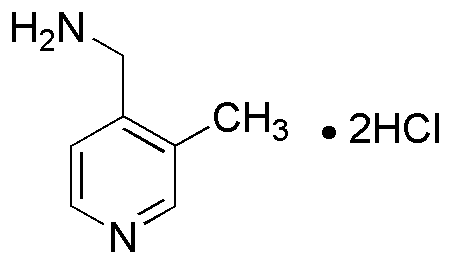4-Aminomethyl-3-methylpyridine dihydrochloride is widely utilized in research focused on:
- Pharmaceutical Development: This compound serves as a key intermediate in synthesizing various pharmaceuticals, particularly those targeting neurological disorders, enhancing drug efficacy.
- Chemical Synthesis: It is employed in organic synthesis as a building block for creating more complex molecules, facilitating the development of new materials and chemicals.
- Research in Catalysis: The compound is used in studies related to catalysis, where it can act as a ligand in metal complexes, improving reaction rates and selectivity in chemical processes.
- Analytical Chemistry: It plays a role in analytical methods, such as chromatography, where it can be used as a derivatizing agent to enhance the detection of certain analytes.
- Biochemical Research: The dihydrochloride form is beneficial in biochemical assays, providing a stable source of the active amine for studying enzyme interactions and metabolic pathways.
General Information
Properties
Safety and Regulations
Applications
4-Aminomethyl-3-methylpyridine dihydrochloride is widely utilized in research focused on:
- Pharmaceutical Development: This compound serves as a key intermediate in synthesizing various pharmaceuticals, particularly those targeting neurological disorders, enhancing drug efficacy.
- Chemical Synthesis: It is employed in organic synthesis as a building block for creating more complex molecules, facilitating the development of new materials and chemicals.
- Research in Catalysis: The compound is used in studies related to catalysis, where it can act as a ligand in metal complexes, improving reaction rates and selectivity in chemical processes.
- Analytical Chemistry: It plays a role in analytical methods, such as chromatography, where it can be used as a derivatizing agent to enhance the detection of certain analytes.
- Biochemical Research: The dihydrochloride form is beneficial in biochemical assays, providing a stable source of the active amine for studying enzyme interactions and metabolic pathways.
Documents
Safety Data Sheets (SDS)
The SDS provides comprehensive safety information on handling, storage, and disposal of the product.
Product Specification (PS)
The PS provides a comprehensive breakdown of the product’s properties, including chemical composition, physical state, purity, and storage requirements. It also details acceptable quality ranges and the product's intended applications.
Certificates of Analysis (COA)
Search for Certificates of Analysis (COA) by entering the products Lot Number. Lot and Batch Numbers can be found on a product’s label following the words ‘Lot’ or ‘Batch’.
Numéro de catalogue
Numéro de lot/série
Certificates Of Origin (COO)
This COO confirms the country where the product was manufactured, and also details the materials and components used in it and whether it is derived from natural, synthetic, or other specific sources. This certificate may be required for customs, trade, and regulatory compliance.
Numéro de catalogue
Numéro de lot/série
Safety Data Sheets (SDS)
The SDS provides comprehensive safety information on handling, storage, and disposal of the product.
DownloadProduct Specification (PS)
The PS provides a comprehensive breakdown of the product’s properties, including chemical composition, physical state, purity, and storage requirements. It also details acceptable quality ranges and the product's intended applications.
DownloadCertificates of Analysis (COA)
Search for Certificates of Analysis (COA) by entering the products Lot Number. Lot and Batch Numbers can be found on a product’s label following the words ‘Lot’ or ‘Batch’.
Numéro de catalogue
Numéro de lot/série
Certificates Of Origin (COO)
This COO confirms the country where the product was manufactured, and also details the materials and components used in it and whether it is derived from natural, synthetic, or other specific sources. This certificate may be required for customs, trade, and regulatory compliance.


